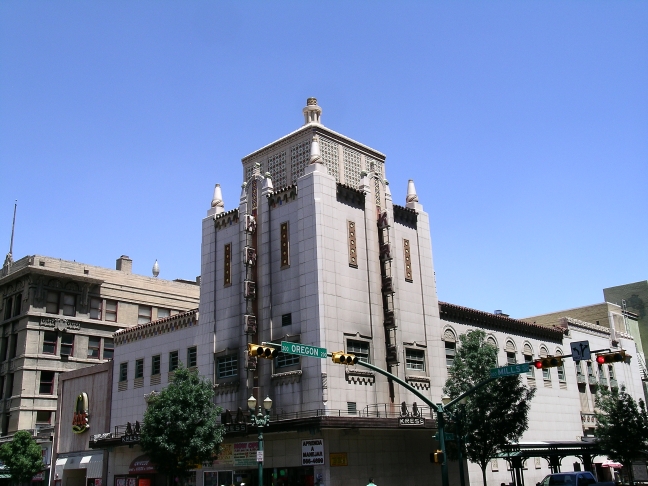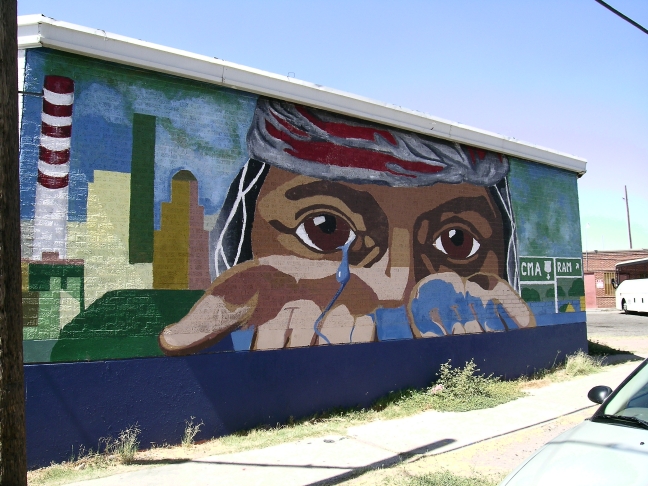Blue Highways: Animas, New Mexico
Unfolding the Map
Click on Thumbnail for MapGhost Dancing, William Least Heat-Moon's (LHM) van, is a very appropriate name as we enter Animas, New Mexico. LHM points out the Native American children, and then turns his attention to the mountains. We'll explore a little more on Native Americans in New Mexico. Click on the thumbnail at right to see where Animas is located.
Book Quote
"...and Animas, with a schoolyard of Indian children, their blue-black heads gleaming like gun barrels in the sun. Then the road turned and went directly for an immense wall of mountain that looked impossible to drive through and improbable to drive around. It was the Chiricahuas, named for the Apache tribe that held this land even before the conquistadors arrived."
Blue Highways: Part 4, Chapter 12
 Animas Post Office. Photo on "courthouselover's" photostream at Flickr. Click on photo to go to site.Animas, New Mexico
Animas Post Office. Photo on "courthouselover's" photostream at Flickr. Click on photo to go to site.Animas, New Mexico
LHM, in his quote above, highlights Native American kids in a schoolyard in Animas. The name may mean "ghosts" or "lost souls," which is very poetic and conjures up all kinds of interesting images. According to some, Animas may have been established on the ruins of an Indian village.
When I moved to New Mexico, I didn't fully appreciate the richness of the cultural heritage of the various native groups in the state. Nor did I understand just how much they contribute to the cultural and economic life of New Mexico.
It sounds ignorant, but I never really gave it much thought. Growing up in California, I don't think I ever saw or met a Native American, at least that I know of. I remember my grandmother, who grew up in a very small town in the woods of northern California, telling me that as a young girl she saw Indians who walked down the road in front of her family's farm on their way to the ocean. She said she was always afraid of them, because she said they were either drunk or they didn't talk to anyone.
My education about Native Americans began in Milwaukee, where my girlfriend and I began attending a Native American Catholic community called Congregation of the Great Spirit. The pastor, who told me that his tribe was Polish, led a congregation made up Natives from a number of different tribes around the Midwest. The celebration of the Mass was almost perfect for us - we were always late for everything but it seemed no matter how late we were, Mass never started before we got there. It was a true community experience. People greeted each other and talked for a long time before the Mass began. Mass started when everyone seemed to think it was supposed to start. The readings, as explained by the pastor, made sense to me finally, because the pastor related Israel's tribal experiences to the Natives tribal experiences and in the process made the context easier to understand. My girlfriend and I were outsiders to the community, but we were never made to feel unwelcome. We were also occasionally invited to participate in some community activities and to go to pow wows.
In New Mexico, there are tribes living on reservations and on pueblos. The tribes living on pueblos are some of the oldest inhabitants of the United States. The Natives practice Catholicism, introduced by the Spanish, and their own native traditional and religious customs. Their ceremonies, some of which are open to outsiders and some which aren't, reflect this mixture of Church and something much older. They built elaborate adobe dwellings and many still live in the traditional communities. If you travel through the northern and western parts of the state, you will see amazing communities like Taos Pueblo, with its multi-story adobe homes and kivas (religious chambers), or Acoma, situated 300 feet above the valley floor on the top of a mesa.
My wife (the girlfriend mentioned above - we were married by the pastor of the Congregation of the Great Spirit in Milwaukee) and I always take visitors to see Acoma, and we were lucky to take a tour of Zuni Pueblo, sponsored by the pueblo, which is not very developed for tourism. Walking through the pueblo, we saw artwork of Kachinas painted in the crumbling church, art they are desperately trying to save. We saw women baking loaves of bread in hornos, mud-ovens introduced by the Moors to the Spanish, and then by the Spanish to the southwest Natives. We ate a traditional Zuni meal at the house of a seventy-year old Zuni midwife who still travels to Albuquerque when called to help deliver children.
I love the creation myths of the Pueblo peoples. The stories say that the first people crawled from the other world through a hole in the ground and settled the lands. This creation story is represented in every kiva in every pueblo in the form of a sipapu - a small hole in ground. It connects the past with the present. Visit Chaco Canyon and its amazing ruins of a long ago Native civilization, or the ruins at Bandelier National Monument, and you will see sipapus in the floor of the ruins of the kivas.
We also, when possible, attend the Gathering of Nations pow-wow in Albuquerque, where representatives of tribes from all over the United States and Canada compete in dancing and strengthen the connections between tribes. Gallup, New Mexico also has a large pow-wow.
Within the past three years, I have discovered that I have the blood of Natives running in me. I was adopted, and did not know my heritage. My biological mother's side has both African-American and Native-American blood (specifically Delaware) running through their veins. I was extremely happy when I found this out. To me, I have the best of America inside me. The creativity and passion and talent and culture that intermingles in me in the form of African, Native and Caucasian, waiting to be tapped, is part of what has made this country what it is.
Lately, as the years have passed while we've lived in Albuquerque, the few artworks and jewelry we have collected have taken a decidedly Southwest Native flavor. Now, instead of going to a church that is for a Native community, we attend Mass at a Church where whites, blacks, Asians and Natives mingle and worship together. The more that I learn, the more that I am astounded at the richness and the vitality of the Native communities in this state, and I am thankful that they are here, expanding my horizons and teaching me new ways to see myself and the world. I know that on the reservation and in the Native communities there are many problems that need to be resolved, and the past treatment of Natives by white settlers and their governments is one of the dark blots on our country's history. However, in my experience with Native peoples, the spirit, or "ánima" of their communities is very alive, and anything but lost.
Musical interlude
At KUNM, one of Albuquerque's public radio stations, the station airs Singing Wire each Sunday afternoon. "Singing Wire," you may recall, was the name that Natives gave to telegraph wires. The show is programmed and hosted by Native American volunteers. They play a lot of pow-wow music, traditional native music, rock and roll and reggae by Native artists. (I've learned that Indians are big fans of hard driving rock and the mellow beats of reggae.) One of our favorite songs that they air often is Indian Car, by Keith Secola. On our way to Chaco Canyon, traveling 25 miles per hour in a rental car on a road that was so rough and washboardy I thought we'd puncture the oil pan, we were passed by an old sedan filled with young Native Americans doing about 60 miles per hour, and as I watched they swerved off the main road onto a road only they knew and headed out across the desert. I think of them every time I hear this song.
If you want to know more about Animas
Animas, Cotton City, and Playas
Wikipedia: Animas
Next up: Portal, Arizona




 Thursday, March 17, 2011 at 7:06AM
Thursday, March 17, 2011 at 7:06AM




